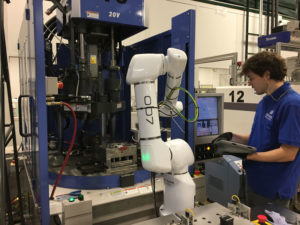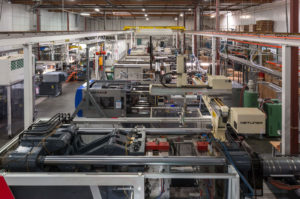by Cynthia Kustush, contributing writer
Plastics Business

It can be difficult to put a finger on the pulse of US manufacturing. For so long it has ebbed and flowed, influenced by many factors including the price of oil, tax and trade policies, workforce development (or the lack thereof) and even disease and natural disaster events here and abroad.
One notable influencing factor is the recently ratified US-Mexico-Canada trade agreement (USMCA). According to The Office of the United States Trade Representative (USTR), key provisions included in the agreement include stronger and more effective protections for the intellectual property rights of US innovators and creators. This includes the most comprehensive enforcement provisions ever laid out in any trade agreement.
Additionally, the USTR states in its trade fact sheet the following: “The new Digital Trade chapter contains the strongest disciplines on digital trade of any international agreement, providing a firm foundation for the expansion of trade and investment in the innovative products and services where the United States has a competitive advantage.”
The renegotiated North American Free Trade Agreement (NAFTA) also includes a key chapter focusing on currency issues, saying that it will “address unfair currency practices by requiring high-standard commitments to refrain from competitive devaluations and targeting exchange rates, while significantly increasing transparency and providing mechanisms for accountability. This approach is unprecedented in the context of a trade agreement and will help reinforce macroeconomic and exchange rate stability.”
It is too soon to gain any meaningful data on how the new USMCA agreement will influence US manufacturing. Still, there is much optimism, as demonstrated by a few MAPP member companies that Plastics Business reached out to for a read on the pulse of their businesses now and in the coming months.
Embracing healthy growth
For Tammy Barras, president of Westec Plastics Corp. (Livermore, California), the fact that the company recently celebrated 50 years in business and continues to grow and improve is proof enough to support an optimistic outlook for 2020. The company currently employs 78, she says, and includes a full, in-house toolroom, a large secondary operations department, 20 injection molding machines and three levels of cleanroom capabilities.
“We have a very diverse customer base with products in defense, agriculture and consumer products,” she added. “Currently, we are focusing our attention on the medical and biotech markets.”
Barras says her company is very customer driven, with a culture that embraces its motto: “Your Concept, Our Expertise, One Partnership.” In that vein, Westec Plastics has rebranded itself, complete with an updated logo and website and a new marketing strategy.
“We’ve focused on increasing our technology and services to best serve our customers,” Barras said. “We’ve added laser engraving, vibration welding, additional ultrasonic welding capabilities and an ISO Class 7 secondary operations cleanroom.” This expansion in capabilities, she explained, will serve to overcome what she says is the company’s biggest ongoing challenge – bringing in new projects from new and existing customers.
Automation offers an advantage

Like Westec Plastics, Noble Plastics (Grand Coteau, Louisiana), also has enjoyed healthy growth year over year, according to President Missy Rogers, P.E., a mechanical engineer who serves on the MAPP board of directors. Noble Plastics is a custom molder and automation integrator, with 50 employees operating within a more than 100,000-square-foot facility. Rogers says her company provides molding services to customers in the defense, oil and gas, and industrial markets with a focus on engineered resins, while automation clients have roots in manufacturing, packaging and palletizing.
“The trend we are seeing is more growth in automation systems than molding,” Rogers said.
The company currently employs six on its automation team and offers the design and development of robotic systems for such tasks as machine tending, product inspection, secondary operations and more. They also design and build custom robotic machinery when customers require something more or different than what is commercially available elsewhere.
At Matrix Plastic Products (Wood Dale, Illinois), automation and advancing technologies are central to the company’s continued growth, particularly when it comes to assisting customers during the R&D phase of projects to guide them through design for manufacturing (DFM) analyses. The company employs 90 people, including second- and third-generation family members who are involved in several key areas of the business.
Anne M. Ziegenhorn, sales and marketing manager, said, “Technology is becoming more readily available, less costly and more capable all the time. We continue to integrate more cameras, sensors and robotics on our production lines, and over time we expect to see these benefits pushing down to our lower-volume programs where, historically, it has been difficult to justify the ROI.”
Matrix recently invested in its first seven-axis collaborative robot, or “cobot” – a Productive Robotics OB7, for loading and unloading a complex, vertical overmolding application. “We also hired a full-time automation engineer to oversee these ongoing projects,” she added.
“Our 42 years of expertise in moldmaking and design continues to be a distinct advantage when providing DFM guidance to our customers,” she said. “Roughly 85 percent of our business is for the medical device market, and the rest is a mix of safety, electronics, personal care and other critical applications in our ‘medium to micro’ sweet spot and molding press range of 20 tons to 300 tons.”
The company also offers “surgical precision” assembly of molded components, something they credit to their expertise in building close-tolerance molds, including micro molds.
Asked about the biggest challenge Matrix is facing in the coming year, Ziegenhorn said that, hands down, it is where to expand its facility.
“Our growth over the past several years has created a need for more physical space, and unfortunately, we are landlocked in our current location. Since another building addition is not an option, we will be continuing our search for a larger facility this year.”
In addition to the facility expansion, she said that training and recruiting experienced talent to keep up with the growth factor will continue to be a challenge, “especially with the fast pace at which our customers are moving.” Matrix has a successful in-house training program, but she says it is difficult to keep up the pace of business without also finding and hiring more seasoned employees, which is an ongoing challenge with which many manufacturers can sympathize.
Looking ahead, opportunity awaits
The optimism shown by Westec Plastics, Noble Plastics and Matrix Plastic Products is almost palpable. Each company is looking at the coming year with 20/20 vision (pun intended) and charging forward with further plans that will enable them to continue growing in size and capabilities.
For example, Westec’s Barras shared that the biggest opportunity for 2020 has been a long time coming. “The last three years have been the most profitable years that Westec has had since the 1980s,” she said. “I think there has been a lot of confidence in the marketplace.”
She explained that Westec is embracing this confidence and will expand its building size by adding 9,200 square feet of production space. “We’re bringing in two-shot molding this year to support customer programs as well,” she added.
Noble Plastics’ Rogers said she and her husband, Scott, technical director, will work to “continue the maturing of our Industry 4.0 platform for our manufacturing business.”
As for Matrix, Ziegenhorn said automation and technology will continue to play a role in opening up “huge opportunities,” including connecting equipment (Industry 4.0) via its enterprise resource management (ERP) system, collecting and analyzing data at each level of production, automating inspection processes, reducing labor requirements and so on.
“We also will need to carefully plan for the buildup of inventory and the timely re-validation of all our medical programs,” she continued. “We’re also excited about a number of new, key medical programs that are wrapping up validation and nearing full production launch, so we are anticipating that 2020 will be a great year for us.”





